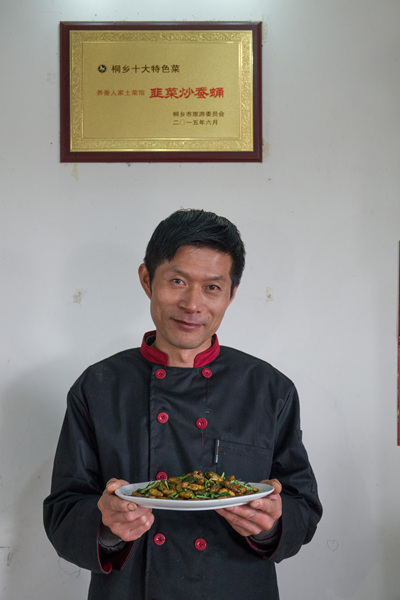Where silkworms appear as food
 |
|
Qian Linqiang presents his signature dish of deep-fried pupae with fresh leeks, one of the "10 must-have dishes" of Tongxiang, the city in which Wuzhen is located. [Photo by Gao Erqiang/China Daily] |
Eating insects is an ancient custom in various Chinese cuisines, but the modern issue of soaring rent has led to a revival of dining on silkworms in Wuzhen.
Qian Linqiang and his wife, Ni Xingfen, once made a fortune running a small restaurant in the touristy town in Zhejiang province. But 30 percent year-on-year tourism growth since 2009 has pushed up property values.
Their business faltered. They didn't offer picture-perfect "food porn" but rather "authentic rustic" fare.
So, the couple moved their eatery, Family of Silkworm Keepers, to Ni's home village, a small settlement 40 minutes' drive from downtown, in 2012.
They set up the restaurant in a two-story factory once used by Ni's father, who owns a small silk-quilt plant.
Business wasn't good in the first few months.
"I think we had more silkworms and other bugs than diners back then," Ni recalls.
The solution, it turned out, was to fry the pupae to feed people.
"It's like a calling card to lure people to our restaurant," Ni says.
The gregarious woman takes care of "everything outside the kitchen", while her more reserved husband works the woks.
Indeed, these creatures have long influenced local life.
The area claims to be the source of the world's earliest known silk artifact.
And silk continues to dominate the local economy.
Silkworms were a traditional snack, for lack of sufficient nutrition in local diets, until the economy picked up about two decades ago.
Silk comes from the creature's cocoons. The pupae inside are edible.
Yet China's 1 billion yuan ($150 million) silk industry today discards 500,000 tons of pupae.
"Eating pupae is very environment-friendly," Ni says.
"It's also cheap. I'm mostly recycling from my father's business." The mom-and-pop restaurant sells over 100 kilograms of silkworms every year.
The deep-fried pupae are sauteed with fresh leeks and served for 18 yuan a plate, making them cheaper than a local taxi ride.
The dish was awarded among the "10 must-have dishes" of Tongxiang, the city in which Wuzhen is located, last year, along with other more famous offerings like red-braised lamb and soy sauce-marinated duck.
The award was based on the votes of both tourists and local chefs.
Business has steadily picked up since. Family of Silkworm Keepers claims to be the only place in Tongxiang serving the pupae.
"Bugs have more protein than beef," Ni says.
"I think it's just a matter of time before many insects find regular places on dining tables. And silkworms could be the first since we're a country known for making silk."
Shandong province is the colloquially known as the "farm" of China's entomophagy. The industry generates over 1 billion yuan in the province annually.
Yunnan province's edible insects are as diverse and expensive as its mushrooms.
And Jiangsu province's Lianyungang city hosts a yearly festival dedicated to dining on hawk moths. A local chef has been named as a national-level inheritor of intangible cultural heritage for the techniques he uses to prepare the bugs.
But Ni and her husband admit they rarely eat silkworms themselves.
"We spend too much time cooking and serving them," she says.




















